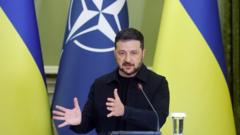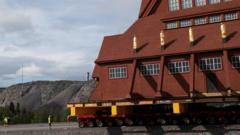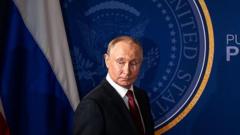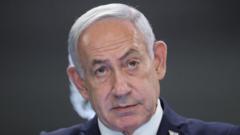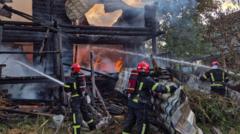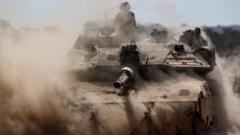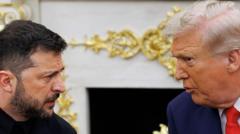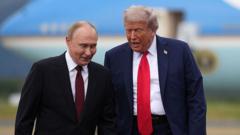With significant stakes involved, the East Ukrainian region's control is essential in determining the balance of power and security in the face of ongoing conflict.
**Donetsk: The Strategic Heartbeat of Ukraine's Defense Against Russian Advances**
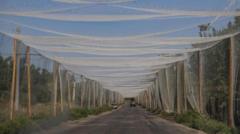
**Donetsk: The Strategic Heartbeat of Ukraine's Defense Against Russian Advances**
The ongoing battle for Donetsk is pivotal not just for territorial integrity but for the future of Ukraine's military strategy.
The conflict in Donetsk continues to be a focal point in the war between Ukraine and Russia. Recent reports from the Alaska summit suggest that Russian President Vladimir Putin is considering a strategy to solidify control over the Donetsk region by freezing the conflict along existing front lines, which would result in Ukraine relinquishing the western part of the oblast already under Russian occupation.
Approximately 70% of Donetsk is currently controlled by Russian forces, including its regional capital. This area has been a battleground for more than a decade, marking it as a priority for both military and political agendas. The loss of western Donetsk for Ukraine could signify not only a deepening humanitarian crisis with potential refugee flows but also a weakening of its defenses against further Russian advances into the heart of the country.
Despite the challenging landscape, Ukraine still retains control of around 6,600 square kilometers of territory in Donetsk, where roughly a quarter of a million individuals remain. Urban centers such as Kramatorsk and Slovyansk are critical hubs that sustain both strategic military operations and economic resilience, albeit severely damaged by ongoing operations. Experts emphasize that the region is unlikely to recover economically for at least a decade, primarily due to extensive landmining and devastation from warfare.
A report from the Institute for the Study of War underscores the significance of what they term a "fortress belt" in western Donetsk—a strategically reinforced area bolstered by trenches, bunkers, and other defensive measures. The conflict dynamics here have evolved into one of attrition, with Russian forces facing tough resistance and finding it challenging to make headway against established Ukrainian defensive positions.
Geographically, the rugged terrain of the Donbas offers both advantages and disadvantages for military maneuvers. Key high ground locations, such as the Chasiv Yar area, are of particular importance for maintaining advantageous observation capabilities and coordinating artillery. Nevertheless, experts point out that the overall topography does not favor the Ukrainians, making their defensive strategy increasingly complex.
As discussions of potential peace negotiations arise, the retention of territory becomes a critical factor for Ukraine. Concerns linger that relinquishing control of western Donetsk could provide Russia with an advantageous launching pad for future military operations. Ukrainian President Volodymyr Zelensky remains firm in the stance of rejecting any proposals that would force Ukraine to cede parts of the Donbas in exchange for a ceasefire.
In summary, the ongoing struggle for Donetsk is not only about the immediacy of military engagements but lays foundational implications for Ukraine's long-term defensive posture against any future aggression from Russia. The fortified defenses and geographical challenges underscore the strategic significance of this region, shaping Ukraine’s resolve to maintain its territorial integrity.
Approximately 70% of Donetsk is currently controlled by Russian forces, including its regional capital. This area has been a battleground for more than a decade, marking it as a priority for both military and political agendas. The loss of western Donetsk for Ukraine could signify not only a deepening humanitarian crisis with potential refugee flows but also a weakening of its defenses against further Russian advances into the heart of the country.
Despite the challenging landscape, Ukraine still retains control of around 6,600 square kilometers of territory in Donetsk, where roughly a quarter of a million individuals remain. Urban centers such as Kramatorsk and Slovyansk are critical hubs that sustain both strategic military operations and economic resilience, albeit severely damaged by ongoing operations. Experts emphasize that the region is unlikely to recover economically for at least a decade, primarily due to extensive landmining and devastation from warfare.
A report from the Institute for the Study of War underscores the significance of what they term a "fortress belt" in western Donetsk—a strategically reinforced area bolstered by trenches, bunkers, and other defensive measures. The conflict dynamics here have evolved into one of attrition, with Russian forces facing tough resistance and finding it challenging to make headway against established Ukrainian defensive positions.
Geographically, the rugged terrain of the Donbas offers both advantages and disadvantages for military maneuvers. Key high ground locations, such as the Chasiv Yar area, are of particular importance for maintaining advantageous observation capabilities and coordinating artillery. Nevertheless, experts point out that the overall topography does not favor the Ukrainians, making their defensive strategy increasingly complex.
As discussions of potential peace negotiations arise, the retention of territory becomes a critical factor for Ukraine. Concerns linger that relinquishing control of western Donetsk could provide Russia with an advantageous launching pad for future military operations. Ukrainian President Volodymyr Zelensky remains firm in the stance of rejecting any proposals that would force Ukraine to cede parts of the Donbas in exchange for a ceasefire.
In summary, the ongoing struggle for Donetsk is not only about the immediacy of military engagements but lays foundational implications for Ukraine's long-term defensive posture against any future aggression from Russia. The fortified defenses and geographical challenges underscore the strategic significance of this region, shaping Ukraine’s resolve to maintain its territorial integrity.

